Best Cell Service in Your Area: Coverage Map Comparison
Who Has the Best Cell Phone Service in My Area? 2025 Edition
Subscribing to the most popular cellular provider doesn’t always guarantee uninterrupted connectivity everywhere. Cellular coverage isn’t universal. It varies by location. The best cell phone provider for you depends on who can keep you connected where you spend most of your time.
In this article, we’ll provide a general phone service and coverage map comparison of Verizon, AT&T, T-Mobile, and US Cellular. While we can’t pinpoint the best provider for your exact address, this overview can help you make an informed decision. And if spotty signal is still a problem at home, in your vehicle, or at work, we can help with that too.
We fix poor cell phone signal! Find the right signal booster for you:




In this guide:
- Verizon Cell Phone Coverage Overview
- AT&T Cell Phone Coverage Overview
- T-Mobile Cell Phone Coverage Overview
- US Cellular Cell Phone Coverage Overview
- MVNO Cell Phone Coverage: Same Coverage, More Affordable
- Cell Phone Provider With the Best Cell Service Per State
- Best Cell Phone Service FAQs
- Improve Your Cell Signal Coverage!
Verizon Cell Phone Coverage Overview
Verizon has the best 4G LTE coverage that spans across 70% of the United States, covering 327 million people in over 2.68 million square miles. Their 5G network has grown 8% since 2024 and continues to grow, now covering about 21% of the United States. Though it’s still lagging slightly behind T-Mobile and AT&T. With that being said, compared to the other major carriers, Verizon’s 5G network experience is superior.
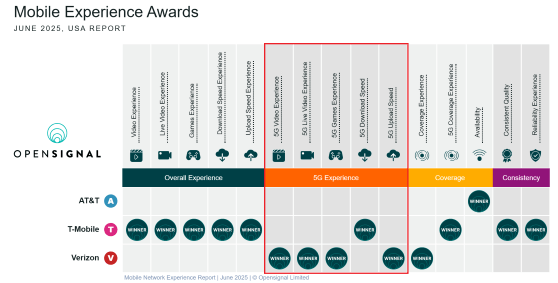
Verizon’s coverage map shows more reliable 4G and 5G coverage on the Eastern side of the country. This makes sense, as the Eastern United States is more densely populated, and the Rocky Mountains are far taller and more infrastructure-intensive than the East’s Appalachians. On the Western side, coverage is slightly more limited in some states, especially in rural areas.
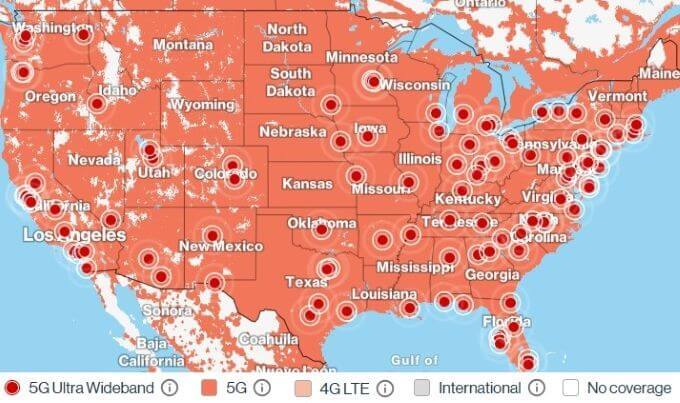
Explore Verizon’s coverage map using your address to see if their 4G or 5G networks are available in your area.
On average, reports state Verizon users maintained a connection 99.5% of the time, just a hairline behind AT&T. The typical everyday download speeds subscribers experience across Verizon's network clock in at around 60.7 Mbps. When connected to 5G, download speeds average 169.5 Mbps.
To deliver coverage everywhere, Verizon is exploring direct-to-cell satellite technology, which will facilitate voice and text over satellites vs. traditional terrestrial cell towers. As of March 2025, they enabled satellite texting on select Samsung Galaxy S25 and Google Pixel 9 series devices.
Verizon’s prices reflect its cell service dominance, having the highest rates for its reliability and superior coverage. You’ll need a 5G compatible device and phone plan to access Verizon’s full capabilities.
Overview:
- #1 in 4G Coverage
- #2 in Service Availability
- #3 in 5G Coverage
- #3 in Average Everyday Download Speeds
AT&T Cell Phone Coverage Overview
AT&T ranks second in 4G and 5G coverage. Its 4G network is available across 68% of the US. AT&T 5G is available across approximately 41%, reaching 315+ million people in more than 26,200 cities and towns.
Mobile experience reports state AT&T users enjoy a reliable connection 99.6% of the time, marginally surpassing Verizon and T-Mobile. This means AT&T subscribers spend the largest amount of time connected to the network in the places that matter.
AT&T also delivers faster speeds than Verizon, but not as fast as T-Mobile. On average, users experience download speeds of 61 Mbps across 4G and 5G networks. When connected to only 5G, download speeds averaged 167.8 Mbps.
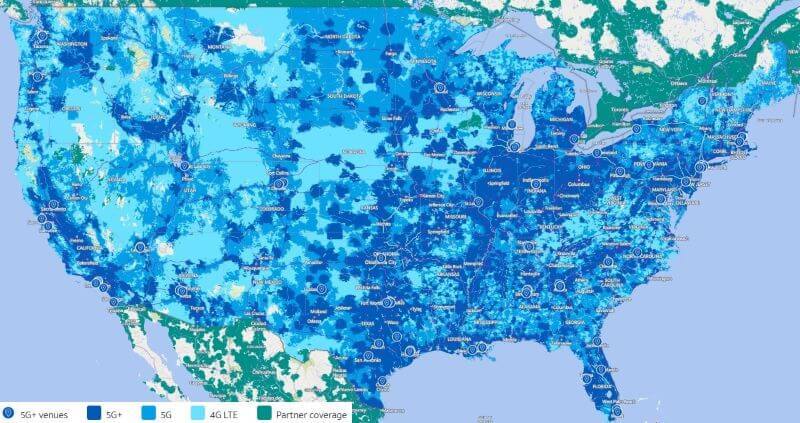
AT&T’s coverage map shows robust coverage across the South, Midwest, and Northeast. Coverage in the West is generally strong, though 5G is more limited and there are noticeable gaps in rural and mountainous regions. To ensure AT&T covers the areas you frequent, check out AT&T’s 4G and 5G coverage map. Big Blue is consistently working on expanding and improving its 5G and 5G+ coverage footprint.
As part of their efforts to expand connectivity, AT&T and AST SpaceMobile are collaborating on direct-to-cell satellite technology. Nearly half of AT&T customers now have access to peer-to-peer messaging and emergency satellite services, with video call capabilities currently in testing.
To tap into AT&T’s 5G cell service where it’s available, 5G phones and plans are required.
Overview:
- #1 in Service Availability
- #2 in 4G Coverage
- #2 in 5G Coverage
- #2 in Average Everyday Download Speeds
T-Mobile Cell Phone Coverage Overview
T-Mobile’s 4G network coverage falls behind AT&T and Verizon. It covers 62% of the US. That’s 8% less than Verizon and 6% less than AT&T.
The Un-carrier makes up for the incremental 4G coverage difference in other areas. They have the largest 5G network and fastest data speeds.
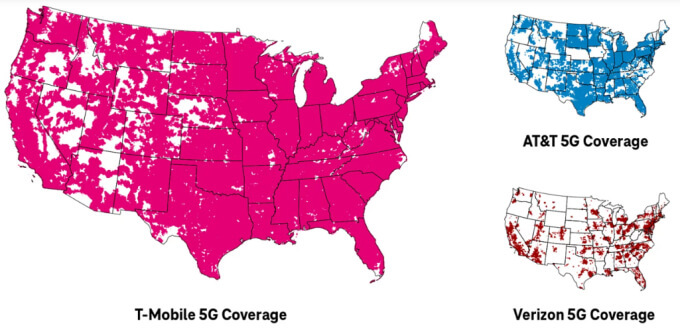
The T-Mobile and Sprint merger expanded T-Mobile's coverage footprint and set them up to build the largest, most reliable 5G network. Thanks to the merger, T-Mobile aims to deliver 14x more network capacity, 15x faster speeds, and 5G for 99% of the US population (including rural America). The US Cellular acquisition will further increase T-Mobile's coverage footprint, particularly in rural areas.
Currently, T-Mobile’s 5G network covers over 332 million people across two million square miles—blanketing 98% of Americans. Its Ultra Capacity 5G, which delivers faster speeds, now reaches more than 305 million people nationwide.
Check out T-Mobile's coverage map to see if they offer 4G or 5G cell service near you.

T-Mobile subscribers report reliable 4G/5G cell service 99% of the time, putting it a tad behind Verizon and AT&T. When it comes down to speed, T-Mobile dominates. Users enjoy average 4G/5G download speeds of 177.5 Mbps, with 5G speeds clocking in at 252.4 Mbps.
T-Mobile is also leading the rollout of 5G Advanced, the next step in 5G. It uses AI and machine learning to make the network faster, smarter, and more responsive. This unlocks new possibilities like cloud gaming, XR experiences, and better location services.
On a mission to eliminate dead zones, T-Mobile partnered with Starlink to create T-Satellite, the largest satellite-to-mobile network. The first direct-to-cell satellite was launched into orbit in January 2024. Now they have 650+ satellites, providing an extra layer of coverage for text messaging where terrestrial towers can’t reach.
To access T-Mobile's superior network, you need a compatible device and service plan.
Overview:
- #1 in 5G Coverage
- #1 in Average Everyday Download Speeds
- #3 in 4G Coverage
- #3 in Service Availability
US Cellular Cell Phone Coverage Overview
After the Sprint and T-Mobile merger, US Cellular was considered the fourth-largest mobile network. However, as of May 2024, T-Mobile has agreed to acquire US Cellular. They will be taking over US Cellular stores and 30% of their RF spectrum. US Cellular will retain ownership of its other spectrum as well as its towers, with T-Mobile leasing space on 2,000+ of those towers through a long-term agreement. The acquisition is expected to close in late 2025 after some delays.
Once finalized, the merger will bring big benefits to US Cellular customers, especially those in rural areas. They'll gain full access to T-Mobile’s nationwide network instead of relying on roaming outside of US Cellular’s footprint. Current customers can expect better coverage in areas where US Cellular has traditionally had stronger signal.
As of the posting of this article, no assets have been transferred, so US Cellular’s coverage remains the same for now. We’ll continue to update this post as new information becomes available.
Respectively, US Cellular’s 4G network covers about 10% of the country, with 5G covering even less.

To achieve nationwide coverage, they have roaming agreements with Verizon, AT&T, and T-Mobile. Subscribers can roam on partnering 4G and 5G networks to remain connected when US Cellular service isn’t available at no extra cost. The coverage map on US Cellular’s website reflects their core network and roaming network combined.
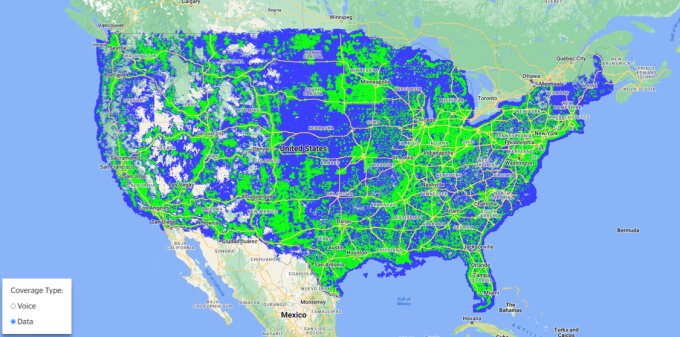
Just because US Cellular devices can access Verizon, AT&T, and T-Mobile networks doesn’t mean great cell service anytime, anywhere. Because the device enters roaming mode outside the core network, reception may be of lower quality. Coverage is expected to change once the acquisition has been finalized.
Just because US Cellular devices can access Verizon, AT&T, and T-Mobile networks doesn’t mean great cell service anytime anywhere. Because the device enters roaming mode outside the core network, reception may be of lower quality. A signal booster can help improve US Cellular voice and data reliability at home or on the go.
MVNO Cell Phone Coverage: Same Coverage, More Affordable
Mobile virtual network operators (MVNOs), also known as prepaid carriers, offer similar coverage as their parent company at more affordable prices. Although, deprioritization is common during times of congestion. Parent carriers prioritize their service to their direct subscribers. Here is a list of different MVNO carrier coverage maps:
- AirVoice Wireless
- Boost Mobile
- Consumer Cellular
- Cricket Wireless
- Google Fi Wireless
- h2o Wireless
- Metro by T-Mobile
- Mint Mobile
- Spectrum Mobile
- Straight Talk
- Tello Mobile
- Ting Mobile
- Total Wireless
- Tracfone
- US Mobile
- Visible Wireless
- Walmart Family Mobile
- Xfinity Mobile
Cell Phone Provider With the Best Cell Service Per State
OpenSignal breaks down which cellular provider offers the best phone service per state in their 2025 Mobile Network Experience Reports. Here are the results:
| Region | Coverage Experience |
Availability | 5G Coverage Experience |
| Alabama | V | A | T |
| Alaska | A | A | N/A |
| Arizona | V | A / V | T |
| Arkansas | V | A | A |
| California | V | A | T |
| Colorado | V | A / T / V | T |
| Connecticut | V | A | T |
| Delaware | V | A / V | T |
| District of Columbia | A / T / V | A / T / V | A / T / V |
| Florida | V | A | T |
| Georgia | V | A / V | T |
| Hawaii | V | A / T / V | T |
| Idaho | V | A / T / V | T |
| Illinois | V | A / V | T |
| Indiana | V | A / V | T |
| Iowa | V | A / V | U |
| Kansas | V | A | T |
| Kentucky | A / V | A | A / T |
| Louisiana | A | A | A |
| Maine | V | A / U / V | T |
| Maryland | V | A / U / V | T |
| Massachusetts | V | A / V | T |
| Michigan | V | A / V | T |
| Minnesota | V | A / V | T |
| Mississippi | A | A | A / T |
| Missouri | A | A / V | T |
| Montana | V | A / T / V | T |
| Nebraska | V | V | V |
| Nevada | V | A / T | T |
| New Hampshire | V | A / U | T |
| New Jersey | V | A / V | T |
| New Mexico | V | A / V | T |
| New York | V | V | T / V |
| North Carolina | V | A | T |
| North Dakota | V | A | V |
| Ohio | V | A / V | T |
| Oklahoma | A | A | A / T |
| Oregon | V | A / V | T |
| Pennsylvania | V | A / U / V | T |
| Rhode Island | V | A / T / V | T |
| South Carolina | V | A / V | T |
| South Dakota | V | A / V | T |
| Tennessee | V | A | T |
| Texas | A | A | A |
| Utah | V | A / T | T |
| Vermont | V | A / T / V | T |
| Virginia | V | A / U / V | T |
| Washington | V | A / T / V | T |
| West Virginia | A | A / U | T |
| Wisconsin | V | A / V | T |
| Wyoming | V | A / V | T |
Improve Your Cell Signal Coverage!
Finding the cell phone company that has the best cell phone service in your area is just the beginning. Even with the best coverage, performance isn’t always the best–especially indoors or on remote roads.
That’s where we can help! Whether you're struggling with dropped calls at home, slow data in the office, or spotty reception in your vehicle, despite subscribing to the carrier with the best cell service in your area, a cell phone signal booster can help. They take your existing cell signal, amplify it, and rebroadcast it indoors, improving 5G/4G connectivity. To learn more, see our guide on how cell phone signal boosters work. Below are our top-sellers:

Strong amplification power. Compatible with all US carriers. Up to 5,000 sq ft of coverage. Ideal for most homes.
Shop Now: $569.99
Most powerful vehicle booster. Compatible with all US carriers. Multiple configurations available to fit any vehicle.
Starting at $499.99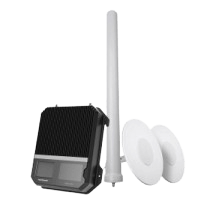
Best-in-class amplifier for small to medium businesses. Compatible with all US carriers. Up to 15,000 sq ft of coverage. Professional installation included.
Shop Now: $3,799.99And with Cellular Path's new self-pointing cellular antenna (coming soon), installing home and business boosters is a breeze. It automatically scans and positions the outdoor antenna to receive the strongest possible signal from your carrier for optimal results.
We specialize in improving cell signal coverage. Our team can help you find the best solution based on your location and signal conditions. Give us a call 800-568-2723, chat with us live, or email us at sales@wilsonamplifiers.com for personalized recommendations. We’re happy to help eliminate dropped calls, failed texts, and slow data!
Best Cell Phone Service FAQs
Which Cell Phone Carrier Has the Most Cell Phone Coverage?
Which Cell Phone Carrier Has the Best 5G Coverage?
Which Cell Phone Carrerier Has the Best Nationwide Cell Phone Coverage?
Which Cell Phone Carrier Has the Best Cell Phone Coverage in My Area?
How Can I Find the Carrier with the Best Cell Service in My Area?
Which Cell Phone Provider Has the Best Cell Phone Reception in Rural Areas?
Why Don’t I Have Good Cell Service Even Though Coverage Maps Show I Should Have Signal?
At Your Wits End with Your Carrier’s Coverage and Cell Service? What Does it Cost to Switch Carriers?
Which Mobile Network is Most Reliable?
Sources
Interested in Learning More? Check Out Our Signal Boosting Info Center


Money Back Guarantee

Technical Support

